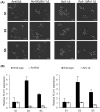Pseudohyphal differentiation in Komagataella phaffii: investigating the FLO gene family
- PMID: 32766781
- PMCID: PMC7419694
- DOI: 10.1093/femsyr/foaa044
Pseudohyphal differentiation in Komagataella phaffii: investigating the FLO gene family
Abstract
Many yeasts differentiate into multicellular phenotypes in adverse environmental conditions. Here, we investigate pseudohyphal growth in Komagataella phaffii and the involvement of the flocculin (FLO) gene family in its regulation. The K. phaffii FLO family consists of 13 members, and the conditions inducing pseudohyphal growth are different from Saccharomyces cerevisiae. So far, this phenotype was only observed when K. phaffii was cultivated at slow growth rates in glucose-limited chemostats, but not upon nitrogen starvation or the presence of fusel alcohols. Transcriptional analysis identified that FLO11, FLO400 and FLO5-1 are involved in the phenotype, all being controlled by the transcriptional regulator Flo8. The three genes exhibit a complex mechanism of expression and repression during transition from yeast to pseudohyphal form. Unlike in S. cerevisiae, deletion of FLO11 does not completely prevent the phenotype. In contrast, deletion of FLO400 or FLO5-1 prevents pseudohyphae formation, and hampers FLO11 expression. FAIRE-Seq data shows that the expression and repression of FLO400 and FLO5-1 are correlated to open or closed chromatin regions upstream of these genes, respectively. Our findings indicate that K. phaffii Flo400 and/or Flo5-1 act as upstream signals that lead to the induction of FLO11 upon glucose limitation in chemostats at slow growth and chromatin modulation is involved in the regulation of their expression.
Keywords: FLO genes; Komagataella phaffii; Pichia pastoris; FAIRE-Seq; epigenetics; pseudohyphal growth; specific growth rate.
© FEMS 2020.
Figures








References
-
- Andrews S, Fast QC. A quality control tool for high throughput sequence data. http://www.bioinformatics.babraham.ac.uk/projects/fastqc/2010, (28 January, 2018, date last accessed).
Publication types
MeSH terms
Substances
Supplementary concepts
Grants and funding
LinkOut - more resources
Full Text Sources
Molecular Biology Databases

